NCERT Solutions for Class 9 Maths Chapter 8 Exercise 8.2 - Quadrilaterals
In the last exercise, the concept of quadrilaterals and their types and properties was explained. In this exercise, the concept of the midpoint theorem is used to solve the questions. The midpoint theorem is also called the midsegment theorem. According to this theorem, the line connecting the midpoint of the two sides of the triangle will be parallel to the third side and half its length.
The figure below shows a triangle ABC, and the line EF passes through the midpoints of the sides AB and AC. Since it divides the sides into two, AE = EB and AB = 2AE

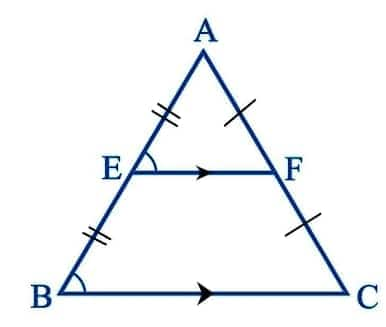
The two theorems that are present in the NCERT solutions for Class 9 Maths chapter 8 exercise 8.2 are:
The line segment joining the midpoints of the two sides of a triangle is parallel to the third side of the triangle (also known as the base of the triangle, generally).
The line segment that is drawn through the midpoint of one side of a triangle, and moves parallel to the third side of the triangle (base) bisects the other side of the triangle into two halves.
This chapter takes you into the study of quadrilaterals, four-sided shapes. 9th class maths exercise 8.2 answers provide practical problems and solutions to help you understand their properties and types. Access these free PDF solutions to improve your understanding, prepare for exams, and strengthen your math skills. The NCERT Solutions for Class 9 Maths Exercise 8.2 deal with concepts that are mostly related to triangles rather than quadrilaterals. The NCERT Books help students to access all the study material according to their requirements.
NCERT Solutions for Class 9 Maths Chapter 8 Quadrilaterals Exercise 8.2
Access Quadrilaterals Class 9 Chapter 8 Exercise: 8.2
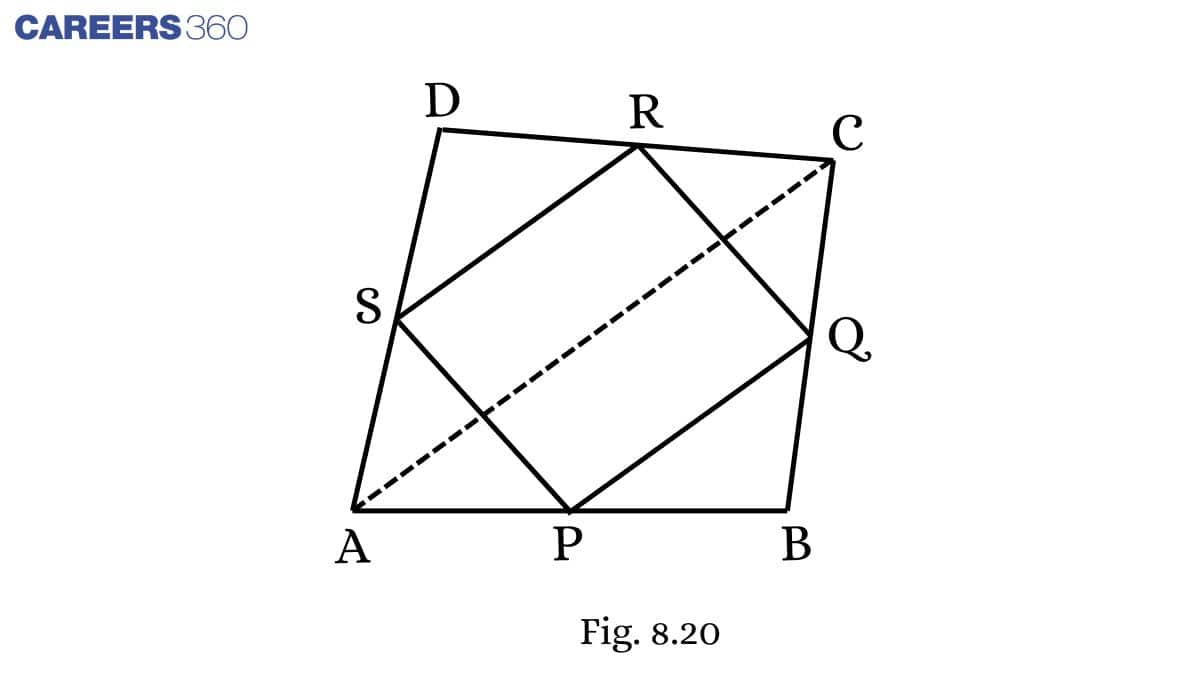
Solution:
Given: ABCD is a quadrilateral in which P, Q, R and S are mid-points of the sides AB, BC, CD and DA (see Fig 8.29 ). AC is a diagonal.
To prove:
SR∥AC and SR=12AC
Proof: In △ ACD,
S is the midpoint of DA. (Given)
R is the midpoint of DC. (Given)
By the midpoint theorem,
SR∥AC and SR=12AC
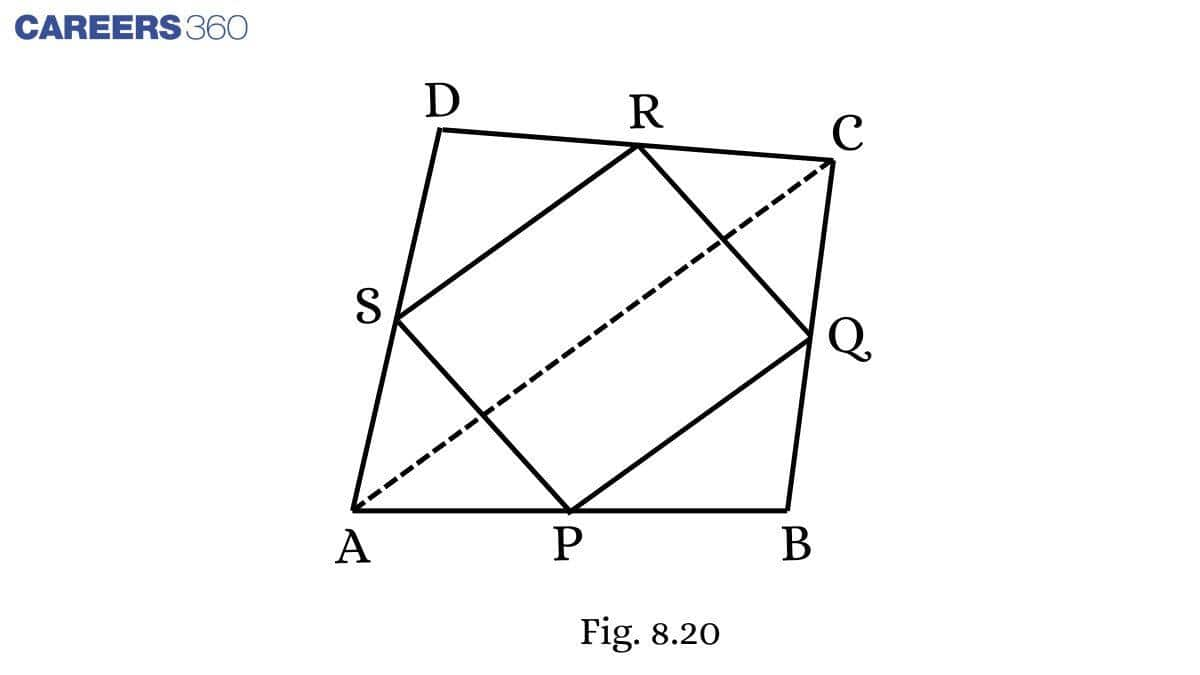
Solution:
Given: ABCD is a quadrilateral in which P, Q, R and S are mid-points of the sides AB, BC, CD and DA (see Fig 8.29 ). AC is a diagonal.
To prove : PQ=SR
Proof: In △ ACD,
S is the midpoint of DA. (Given)
R is the midpoint of DC. (Given)
By the mid-point theorem,
SR∥AC and SR=12AC ...........(1)
In △ ABC,
P is the midpoint of AB. (Given)
Q is the midpoint of BC. (Given)
By the mid-point theorem,
PQ∥AC and PQ=12AC ..............(2)
From 1 and 2, we get
PQ∥SR and PQ=SR=12AC
Thus, PQ=SR
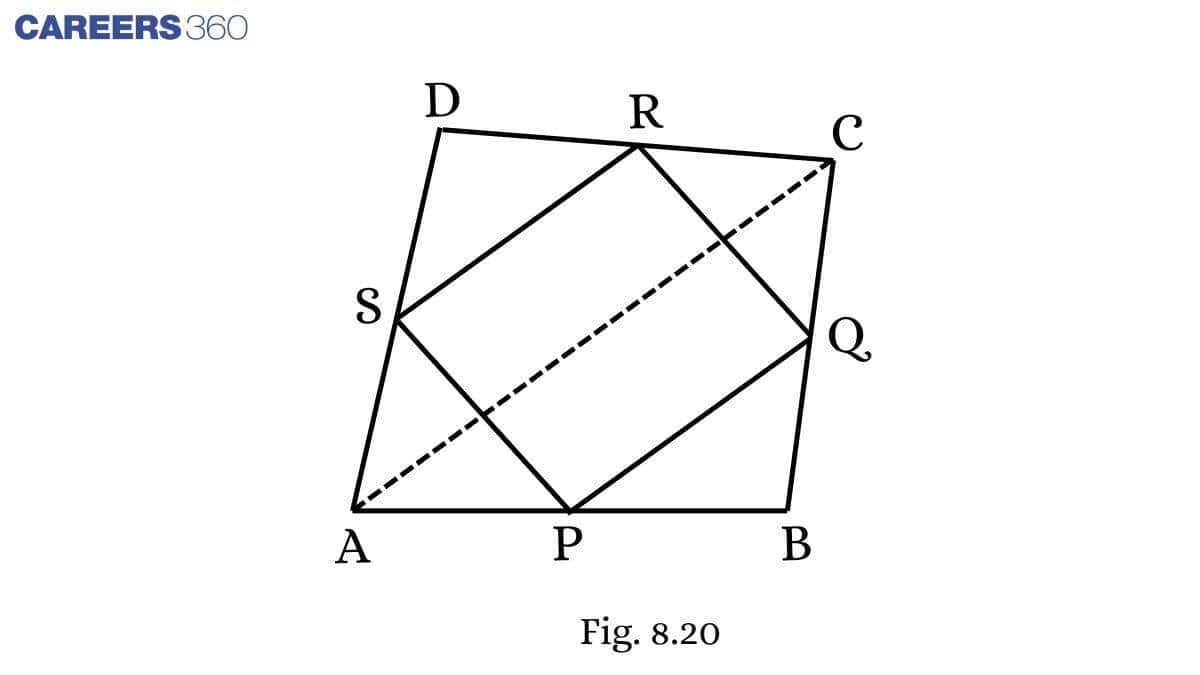
Solution:
Given: ABCD is a quadrilateral in which P, Q, R and S are mid-points of the sides AB, BC, CD and DA (see Fig 8.29 ). AC is a diagonal.
To prove: PQRS is a parallelogram.
Proof: In PQRS,
Since,
PQ∥SR and PQ=SR .
So, PQRS is a parallelogram.
Solution:
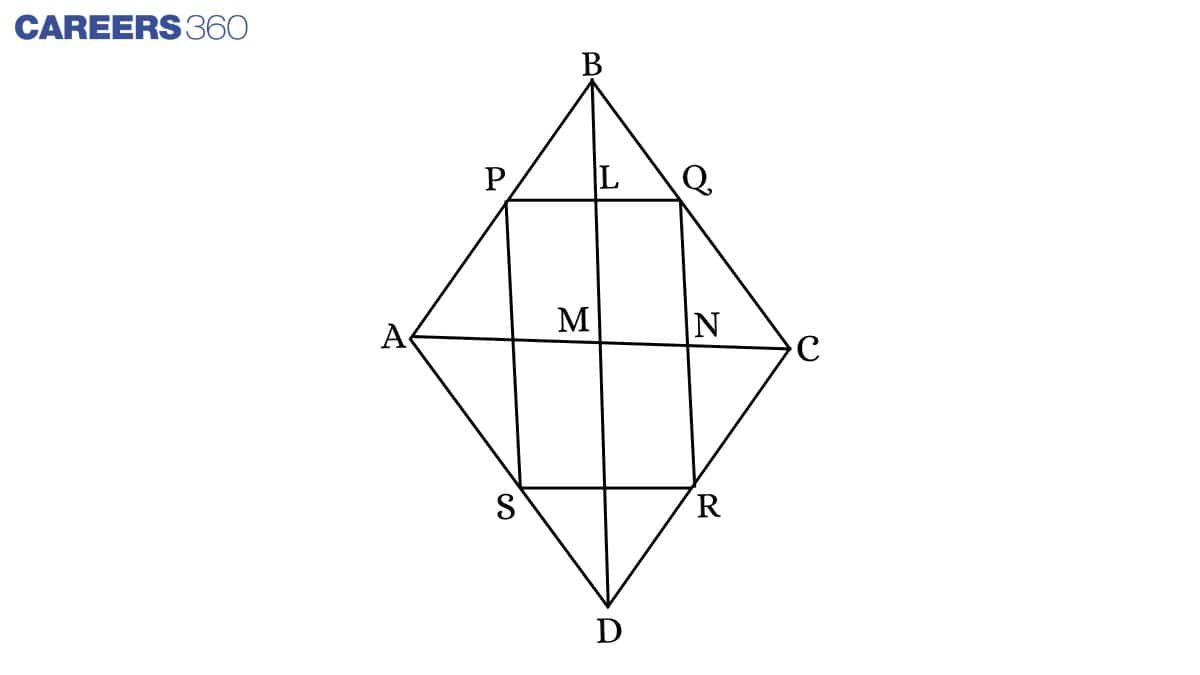
Given: ABCD is a rhombus in which P, Q, R and S are mid-points of the sides AB, BC, CD and DA. AC, BD are diagonals.
To prove: the quadrilateral PQRS is a rectangle.
Proof: In △ ACD,
S is the midpoint of DA. (Given)
R is the midpoint of DC. (Given)
By the midpoint theorem,
SR∥AC and SR=12AC ........(1)
In △ ABC,
P is the midpoint of AB. (Given)
Q is the midpoint of BC. (Given)
By the mid-point theorem,
PQ∥AC and PQ=12AC ...........(2)
From (1) and (2), we get
PQ∥SR and PQ=SR=12AC
Thus, PQ=SR and PQ∥SR
So, the quadrilateral PQRS is a parallelogram.
Similarly, in △ BCD,
Q is the midpoint of BC. (Given)
R is the midpoint of DC. (Given)
By the midpoint theorem,
QR∥BD
So, QN || LM .........(5)
LQ || MN ..........(6) (Since, PQ || AC)
From (5) and (6), we get
LMPQ is a parallelogram.
Hence, ∠ LMN= ∠ LQN (opposite angles of the parallelogram)
But, ∠ LMN= 90° (Diagonals of a rhombus are perpendicular)
So, ∠ LQN = 90°
Thus, a parallelogram whose one angle is a right angle is a rectangle. Hence, PQRS is a rectangle.
Solution:

Given: ABCD is a rectangle and P, Q, R, and S are midpoints of the sides AB, BC, CD and DA, respectively.
To prove: the quadrilateral PQRS is a rhombus.
Proof:
In △ ACD,
S is the midpoint of DA. (Given)
R is the midpoint of DC. (Given)
By the midpoint theorem,
SR∥AC and SR=12AC ..........(1)
In △ ABC,
P is the midpoint of AB. (Given)
Q is the midpoint of BC. (Given)
By the midpoint theorem,
PQ∥AC and PQ=12AC ..........(2)
From (1) and (2), we get
PQ∥SR and PQ=SR=12AC
Thus, PQ=SR and PQ∥SR
So, the quadrilateral PQRS is a parallelogram.
Similarly, in △ BCD,
Q is the midpoint of BC. (Given)
R is the midpoint of DC. (Given)
By the midpoint theorem,
QR∥BD and QR=12BD ...........(3)
AC = BD........(4) (diagonals )
From (2), (3) and (4), we get
PQ = QR
Thus, a parallelogram whose adjacent sides are equal is a rhombus. Hence, PQRS is a rhombus.
.jpg)
Solution:
Given: ABCD is a trapezium in which AB∥DC , BD is a diagonal and E is the mid-point of AD. A line is drawn through E parallel to AB intersecting BC at F (see Fig. 8.30 ).
To prove: F is the midpoint of BC.
In △ ABD,
E is the midpoint of AD. (Given)
EG || AB (Given)
By the converse of the midpoint theorem,
G is the midpoint of BD.
In △ BCD,
G is the midpoint of BD. (Proved above)
FG || DC (Given)
By the converse of the midpoint theorem,
F is the midpoint of BC.

Solution:
Given: In a parallelogram ABCD, E and F are the mid-points of sides AB and CD, respectively
To prove: the line segments AF and EC trisect the diagonal BD.
Proof: In quadrilateral ABCD,
AB = CD (Given)
12AB=12CD
⇒AE=CF (E and F are midpoints of AB and CD)
In quadrilateral AECF,
AE = CF (Given)
AE || CF (Opposite sides of a parallelogram)
Hence, AECF is a parallelogram.
In △ DCQ,
F is the midpoint of DC. (given )
FP || CQ (AECF is a parallelogram)
By the converse of the midpoint theorem,
P is the midpoint of DQ.
DP = PQ........(1)
In △ ABP,
E is the midpoint of AB. (given )
EQ || AP (AECF is a parallelogram)
By the converse of the midpoint theorem,
Q is the midpoint of PB.
PQ = QB........(2)
From (1) and (2), we have
DP = PQ = QB.
Hence, the line segments AF and EC trisect the diagonal BD.
Solution: 
Given: ABC is a right-angled triangle right-angled at C. A line through the mid-point M of the hypotenuse AB and parallel to BC intersects AC at D.
To prove: D is the midpoint of AC.
Proof: In △ ABC,
M is the midpoint of AB. (Given)
DM || BC (Given)
By the converse of the midpoint theorem,
D is the midpoint of AC.
Solution:
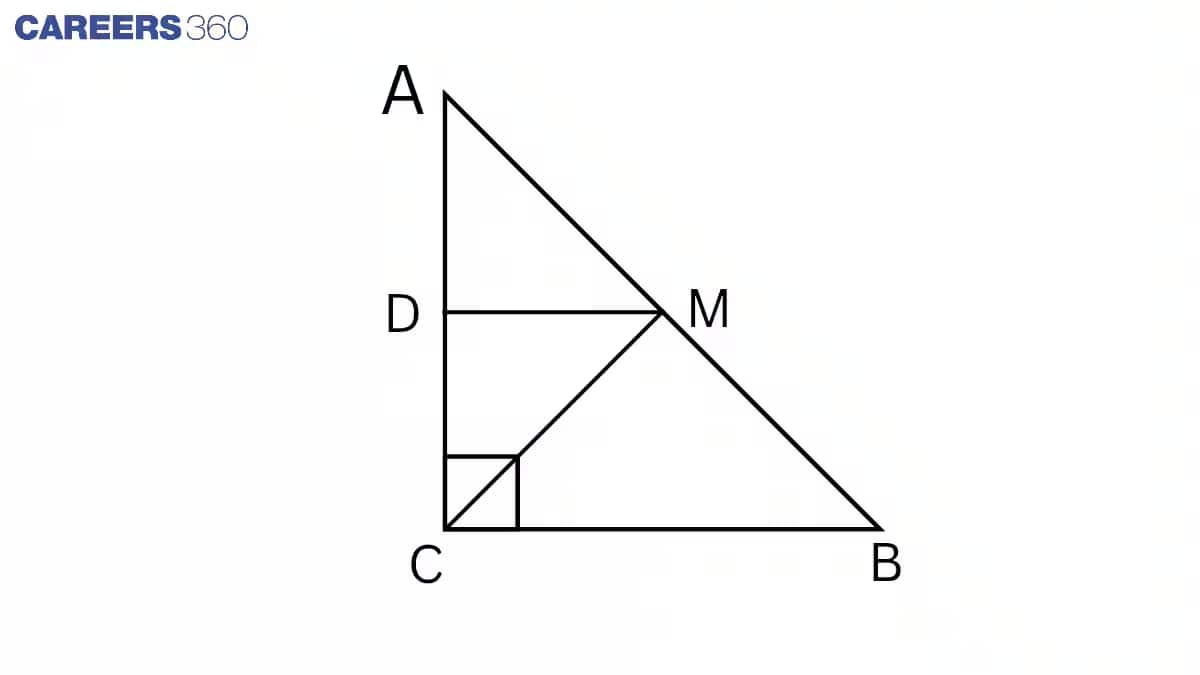
Given: ABC is a right-angled triangle right-angled at C. A line through the mid-point M of the hypotenuse AB and parallel to BC intersects AC at D.
To prove : MD⊥AC
Proof : ∠ ADM = ∠ ACB (Corresponding angles)
∠ ADM= 90∘ . ( ∠ ACB = 90∘ )
Hence, MD⊥AC .
Solution:
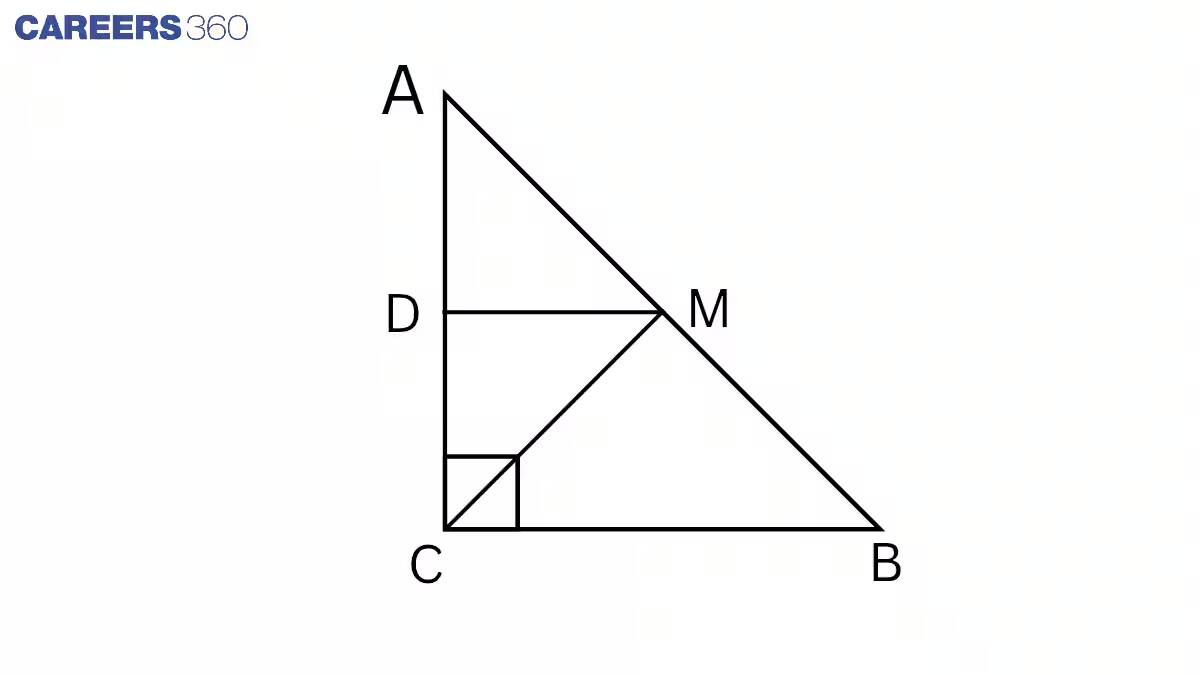
Given: ABC is a right-angled triangle right-angled at C. A line through the mid-point M of the hypotenuse AB and parallel to BC intersects AC at D.
To prove : CM=MA=12AB
Proof : In △ ABC,
M is the midpoint of AB. (Given)
DM || BC (Given)
By the converse of the midpoint theorem,
D is the midpoint of AC, i.e. AD = DC.
In △ AMD and △ CMD,
AD = DC (proved above)
∠ ADM = ∠ CDM (Each right angle)
DM = DM (Common)
△ AMD ≅ △ CMD (By SAS)
AM = CM (CPCT)
But , AM=12AB
Hence, CM=MA=12AB .
Also Read
Topics covered in Chapter 8, Quadrilateral: Exercise 8.2
Midpoint algorithm - This algorithm defines the midpoint of the sides of the triangle. When these two midpoints join, then this line segment is parallel to the third side of the triangle. This is also applicable to the trapezium.
Properties and applications of the algorithm - Some applications are for solving for unknown sides and angles, proving parallelograms, solving problems related to triangles, etc.
Also, See
NCERT Solutions of Class 10 Subject Wise
Students must check the NCERT solutions for Class 9 Maths and Science given below:
Subject Wise NCERT Exemplar Solutions
Students must check the NCERT exemplar solutions for Class 9 Maths and Science given below:
Frequently Asked Questions (FAQs)
The sum of all the angles of a quadrilateral that has four sides is 360 and the sum of the angles of a triangle is 180 degrees. A triangle has three sides
The midpoint hypothesis expresses that assuming a line segment is drawn joining the midpoints of any different sides of a triangle it is parallels corresponding to the third side and is equivalent to half of the length of the third side.
It will also pass through the mid-point of the other side.
The area of the smaller triangle formed will be one-fourth of the area of the original triangle.
The new smaller triangle will always be similar to the original triangle if it is formed by the line parallel to the base that passes through the mid-points of the side of the triangle.
A total of four triangles are formed when all the diagonals are drawn inside a quadrilateral.
NCERT solutions for Class 9 Maths exercise 8.2 is based mid-point theorem and its application.
Popular Questions
Courses After 12th
Study Resources, Applications and Opportunities
Take Aakash iACST and get instant scholarship on coaching programs.
NEET Most scoring concepts
Get nowThis ebook serves as a valuable study guide for NEET 2025 exam.
NEET Previous 10 Year Questions
Get nowThis e-book offers NEET PYQ and serves as an indispensable NEET study material.
JEE Main Important Physics formulas
Get nowAs per latest syllabus. Physics formulas, equations, & laws of class 11 & 12th chapters
JEE Main Important Chemistry formulas
Get nowAs per latest syllabus. Chemistry formulas, equations, & laws of class 11 & 12th chapters
JEE Main high scoring chapters and topics
Get nowAs per latest 2024 syllabus. Study 40% syllabus and score upto 100% marks in JEE

